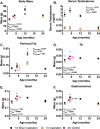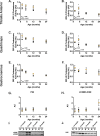Maintenance of muscle mass in adult male mice is independent of testosterone
- PMID: 33764986
- PMCID: PMC7993603
- DOI: 10.1371/journal.pone.0240278
Maintenance of muscle mass in adult male mice is independent of testosterone
Abstract
Testosterone is considered a potent anabolic agent in skeletal muscle with a well-established role in adolescent growth and development in males. However, the role of testosterone in the regulation of skeletal muscle mass and function throughout the lifespan has yet to be fully established. While some studies suggest that testosterone is important for the maintenance of skeletal muscle mass, an understanding of the role this hormone plays in young, adult, and old males with normal and low serum testosterone levels is lacking. We investigated the role testosterone plays in the maintenance of muscle mass by examining the effect of orchiectomy-induced testosterone depletion in C57Bl6 male mice at ages ranging from early postnatal through old age (1.5-, 5-, 12-, and 24-month old mice). Following 28 days of testosterone depletion, we assessed mass and fiber cross-sectional-area (CSA) of the tibialis anterior, gastrocnemius, and quadriceps muscles. In addition, we measured global rates of protein synthesis and degradation using the SuNSET method, western blots, and enzyme activity assays. Twenty-eight days of testosterone depletion resulted in reduced muscle mass in the two youngest cohorts, but had no effect in the two oldest cohorts. Mean CSA decreased only in the youngest cohort and only in the tibialis anterior muscle. Testosterone depletion resulted in a general increase in proteasome activity at all ages. No change in protein synthesis was detected at the terminal time point. These data suggest that within physiological serum concentrations, testosterone may not be critical for the maintenance of muscle mass in mature male mice; however, in young mice testosterone is crucial for normal growth.
Conflict of interest statement
The authors have read the journal’s policy and have the following competing interests: Dr. Bodine is a paid consultant to Calico, LLP (https://www.calicolabs.com/). There are no patents, products in development or marketed products associated with this research to declare. This does not alter our adherence to PLOS ONE policies on sharing data and materials.
Figures





Similar articles
-
Testosterone represses ubiquitin ligases atrogin-1 and Murf-1 expression in an androgen-sensitive rat skeletal muscle in vivo.J Appl Physiol (1985). 2010 Feb;108(2):266-73. doi: 10.1152/japplphysiol.00490.2009. Epub 2009 Nov 19. J Appl Physiol (1985). 2010. PMID: 19926828
-
The effects of testosterone deprivation and supplementation on proteasomal and autophagy activity in the skeletal muscle of the male mouse: differential effects on high-androgen responder and low-androgen responder muscle groups.Endocrinology. 2013 Dec;154(12):4594-606. doi: 10.1210/en.2013-1004. Epub 2013 Oct 8. Endocrinology. 2013. PMID: 24105483 Free PMC article.
-
Muscle sparing in muscle RING finger 1 null mice: response to synthetic glucocorticoids.J Physiol. 2011 Oct 1;589(Pt 19):4759-76. doi: 10.1113/jphysiol.2011.212845. Epub 2011 Aug 1. J Physiol. 2011. PMID: 21807613 Free PMC article.
-
Out of Control: The Role of the Ubiquitin Proteasome System in Skeletal Muscle during Inflammation.Biomolecules. 2021 Sep 8;11(9):1327. doi: 10.3390/biom11091327. Biomolecules. 2021. PMID: 34572540 Free PMC article. Review.
-
Dynamics and Interplay between Autophagy and Ubiquitin-proteasome system Coordination in Skeletal Muscle Atrophy.Curr Mol Pharmacol. 2022;15(3):475-486. doi: 10.2174/1874467214666210806163851. Curr Mol Pharmacol. 2022. PMID: 34365963 Review.
Cited by
-
Percent body fat was negatively correlated with Testosterone levels in male.PLoS One. 2024 Jan 3;19(1):e0294567. doi: 10.1371/journal.pone.0294567. eCollection 2024. PLoS One. 2024. PMID: 38170701 Free PMC article.
-
Effect of Mitotane on Male Gonadal Function.Cancers (Basel). 2023 Jun 18;15(12):3234. doi: 10.3390/cancers15123234. Cancers (Basel). 2023. PMID: 37370841 Free PMC article.
-
Systemic delivery of a mitochondria targeted antioxidant partially preserves limb muscle mass and grip strength in response to androgen deprivation.Mol Cell Endocrinol. 2021 Sep 15;535:111391. doi: 10.1016/j.mce.2021.111391. Epub 2021 Jul 7. Mol Cell Endocrinol. 2021. PMID: 34245847 Free PMC article.
-
Orchiectomy sensitizes cortical bone in male mice to the harmful effects of kynurenine.Bone. 2023 Aug;173:116811. doi: 10.1016/j.bone.2023.116811. Epub 2023 May 25. Bone. 2023. PMID: 37244427 Free PMC article.
-
Carnosic acid prevents heat stress-induced oxidative damage by regulating heat-shock proteins and apoptotic proteins in mouse testis.Biol Chem. 2024 Dec 6;405(11-12):745-749. doi: 10.1515/hsz-2023-0374. Print 2024 Dec 17. Biol Chem. 2024. PMID: 39630978
References
-
- Richter EA, Hargreaves M. Exercise, GLUT4, and Skeletal Muscle Glucose Uptake. Physiol Rev [Internet]. 2013;93(3):993–1017. Available from: http://physrev.physiology.org/cgi/doi/10.1152/physrev.00038.2012. - DOI - PubMed
-
- Bonaldo P, Sandri M. Cellular and molecular mechanisms of muscle atrophy. Dis Model Mech [Internet]. 2013;6(1):25–39. Available from: http://www.pubmedcentral.nih.gov/articlerender.fcgi?artid=3529336&tool=p.... 10.1242/dmm.010389 - DOI - PMC - PubMed
-
- Hohl A. Testosterone—From Basic to Clinical Aspects. Springer; 2017.
Publication types
MeSH terms
Substances
Grants and funding
LinkOut - more resources
Full Text Sources
Other Literature Sources

